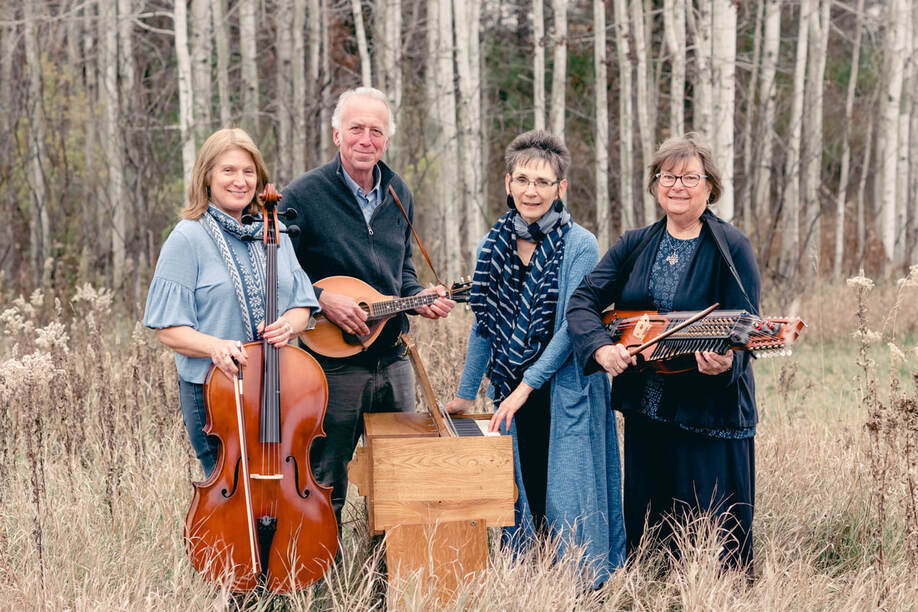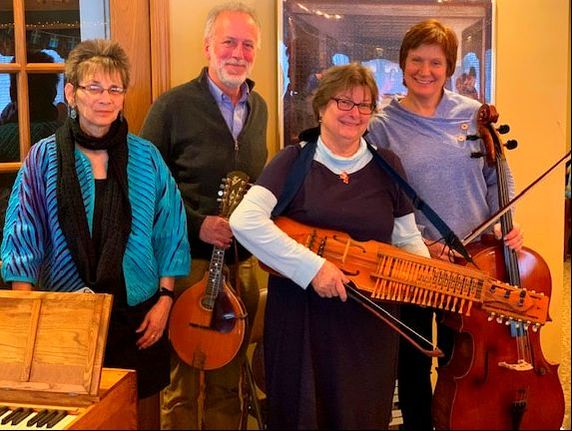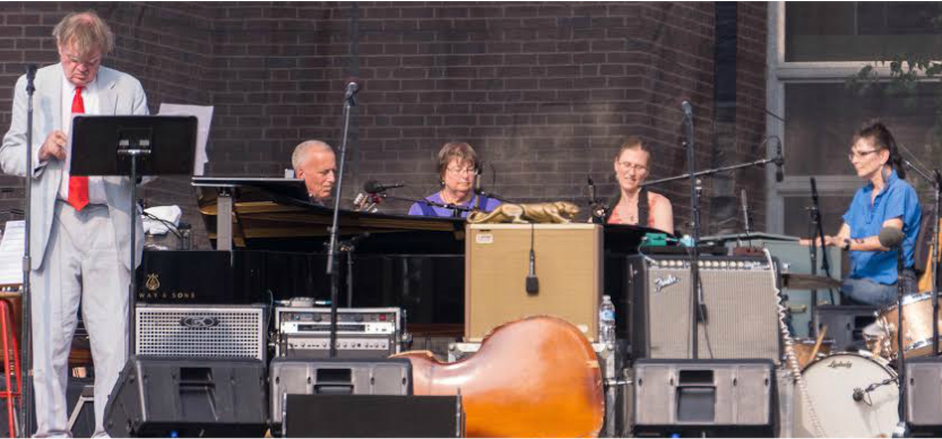Tjärnblom, Swedish for "woodland lake flower", is a Scandinavian-style string band featuring a beautiful blend of Nyckelharpa, Octave Mandolin, Harmonium and Cello. They travel a modern "Snoose Boulevard Highway" in a musical journey, and play a repertoire of both old and new Swedish, Finnish, and Minnesota tunes for dancing and for listening. They’ve performed across the state of Minnesota, and have appeared on Minnesota Public Radio’s A Prairie Home Companion show. The name Tjärnblom is in honor of the Swedish grandfather of one of the band members.
Tjärnblom releases new CD Woods Almost six years have passed since Tjärnblom’s last CD, Starry-Eyed, was released. Band member Mary Crimi set off in pursuit of new adventures, opening the door for multi-instrumentalist Erin Walsh, whose cello has added a deep, rich layer to our tunes while her compositions enliven our repertoire. Erin joins founding members Cheryl Paschke on nyckelharpa and Joe Alfano on mandolin and guitar, along with long-time bandmate Val Eng on harmonium.
As Tjärnblom transformed, political divides in our country intensified and then—a global pandemic struck. We were, you could say, lost in the woods. And when you are lost you begin to look for a path. |
After months of pandemic isolation, we made our first small steps toward reuniting—initially online via Zoom, followed by rehearsals outdoors in garages and on sidewalks, and finally, indoors, masked-up and with air purifiers going strong. Living through this time together as a band inspired a greater appreciation of our friendship and our love of making music.
As musicians, we don’t always stay on the well-worn path. We wander off into the undergrowth…sometimes dew soaks our cuffs…we discover new ways to play our tunes. The woods can be a dark and mysterious place, but they can also be a place of peace, beauty, and discovery. In the fourteen tunes we offer here, joy, sorrow, solitude, and resilience reverberate from the wood of each of our instruments and from our hearts. Journey through Woods with us as we find our way through these times … tillsammans (together).
—Joe Alfano, on behalf of Tjärnblom
Tjärnblom's Woods CD Release Concert and Reception
Friday, SEPTEMBER 29th. . . . .7:00pm - 8:30pm
American Swedish Institute, 2600 Park Ave, Minneapolis, MN 55407
Admission $10 ($5.00 ASI member) Purchase Tickets at www.asimn.org
As musicians, we don’t always stay on the well-worn path. We wander off into the undergrowth…sometimes dew soaks our cuffs…we discover new ways to play our tunes. The woods can be a dark and mysterious place, but they can also be a place of peace, beauty, and discovery. In the fourteen tunes we offer here, joy, sorrow, solitude, and resilience reverberate from the wood of each of our instruments and from our hearts. Journey through Woods with us as we find our way through these times … tillsammans (together).
—Joe Alfano, on behalf of Tjärnblom
Tjärnblom's Woods CD Release Concert and Reception
Friday, SEPTEMBER 29th. . . . .7:00pm - 8:30pm
American Swedish Institute, 2600 Park Ave, Minneapolis, MN 55407
Admission $10 ($5.00 ASI member) Purchase Tickets at www.asimn.org
View Tjärnblom performing at the Prairie Home Companion ShowTaped live on the lawn at Macalester College, Saint Paul, Minnesota, on July 4, 2015
|
Our Instruments
The Nyckelharpa |
The Nyckelharpa is historically a Swedish folk instrument, now played around the world. In earliest form, it dates to the 14th century; followed by related instruments in the 17th and 18th centuries. We play the 20th century version, which has 16 strings. Three of these strings have 'keys' tuned chromatically for playing melody in a three-octave range. One of the strings is without keys; tuned to a low C it functions as a drone, chord or melody note. Twelve sympathetic strings which are tuned to the 12-note chromatic (Western) scale, resonate as the main strings are played. All forms of the instrument are played with a short bow.
|
The Mandolin |
The Mandolin, Octave Mandolin and Guitar are all fretted instruments played by picking and strumming. The mandolins have 8 strings tuned in pairs; the guitar has 6 strings. They are played in many cultures, and musical genres, as both melodic and accompanying instruments.
|
The Harmonium |
The harmonium is a type of portable organ that generates sounds by the pumping of foot pedals to fill the bellows, which in turn oscillate the reeds to create sound when the keys are pressed. Our instrument has two knee pedals which, when used along with the foot pedals, change both the character and volume of the sound, resulting in three distinct voices. Made by the Estey Organ Company in the first half of the 20th Century, it’s also known as a chaplain or field organ. These instruments have a rich history including being used in religious services on battlefields in WWI and WWII and by street preachers in the early 1900’s. Recently they have become popular instrument in Scandinavian folk music bands.
|
The Cello |
The cello is a bass instrument member in the violin family. It has 4 strings pitched C G D A and can be played by bowing or plucking. The earliest cellos are found in the 16th century. The cello is found in ensembles in many musical settings including Nordic folk music.
|




